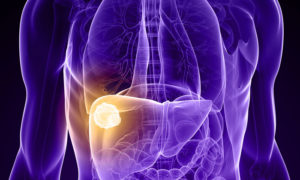Hepatocellular Carcinoma Serum Samples
Bay Biosciences provides fresh frozen (-80°), high quality, clinical grade serum (sera), plasma and peripheral blood mononuclear cells (PBMC) biofluid samples processed from patient’s whole-blood using customized processing protocols. The serum (sera), plasma and PBMC biofluid samples are provided with matching tumor tissue FFPE blocks from unique patients diagnosed with Hepatocellular Carcinoma-HCC (Liver cancer).
Detailed clinical data and pathology annotations including patient’s corresponding diagnostic test values associated with the HCC (liver cancer) tumor tissue samples with matching serum (sera), plasma and PBMC biofluid samples are provided to a valued pharmaceutical customer for drug discovery, development and research.

Liver Cancer Overview
Cancer begins when healthy cells change and grow out of control, forming a mass called a tumor. A tumor can be cancerous or benign. A cancerous tumor is malignant, meaning it can grow and spread to other parts of the body. A benign tumor means the tumor can grow but will not spread. Hepatocellular carcinoma (HCC) is the most common type of primary liver cancer. Hepatocellular carcinoma occurs most often in people with chronic liver diseases, such as cirrhosis caused by hepatitis B or hepatitis C infection. However, up to 25% of patients have no history of cirrhosis or risk factors for it. In the United States, HCC is the ninth leading cause of cancer deaths.
Types of Liver Cancer
There are a several different types of primary liver cancer that occur in adults. They are named for the type of cell from which the cancer develops.
Hepatocellular Carcinoma (HCC)
Approximately 75% of primary liver cancers found in adults are hepatocellular carcinomas. Hepatocellular carcinoma can have different growth patterns. Some spread tentacle-like growths through the liver. This pattern is the most common one in the United States. Some start as a single tumor that spreads to other parts of the liver as the disease develops. Others develop as nodules at several different places in the liver. Occasionally, a pattern isn’t clear.
Hepatocellular carcinoma (HCC) is the most common type of primary liver cancer. Hepatocellular carcinoma occurs most often in people with chronic liver diseases, such as cirrhosis caused by hepatitis B or hepatitis C infection.
The risk of hepatocellular carcinoma is higher in people with long-term liver diseases and if liver is scarred by infection with hepatitis B or hepatitis C. Hepatocellular carcinoma is more common in people who drink large amounts of alcohol and who have an accumulation of fat in the liver.
Cholangiocarcinoma, also known as Bile Duct Cancer
Cholangiocarcinoma develops from cells in the bile duct of the liver. The bile duct is a thin tube that extends from the liver to the small intestine. The bile duct starts inside the liver as several smaller tubes that join together.
Angiosarcoma
Angiosarcoma starts in the blood vessels of the liver and grows very quickly.
Signs and Symptoms of Liver Cancer – Hepatocellular Carcinoma (HCC)
When Hepatocellular Carcinoma (HCC) is diagnosed, some patients will already know that they have cirrhosis and will be receiving care from a doctor. Some symptoms experienced by patients with Hepatocellular Carcinoma (HCC) may be caused by cirrhosis rather than the tumor. These symptoms include abdominal swelling from fluid accumulation, called ascites, and needing more water tablets, called diuretics, to control the fluid accumulation. Hepatic encephalopathy (mental confusion) and bleeding from the esophagus or stomach, or any worsening of the condition, may also indicate cancer.
Patients with Hepatocellular Carcinoma (HCC) may experience no symptoms, particularly when the tumor is detected early as part of a screening program. When symptoms or signs do occur, they include:
- Abdominal Pain at the top right area, near the right shoulder blade, or pain in the back
- Unexplained weight loss
- A hard lump under the ribs on the right side of the body, which could be the tumor or a sign of enlarged liver
- Fatigue or weakness
Risk Factors of Liver Cancer – Hepatocellular Carcinoma (HCC)
A risk factor is anything that increases a person’s chance of developing cancer and other health conditions. Although risk factors often influence the development of cancer, most do not directly cause cancer. Some people with several risk factors never develop cancer, while others with no known risk factors do.
The following factors can raise a person’s risk of developing Hepatocellular Carcinoma (HCC). The main risks in the United States are cirrhosis of the liver and nonalcoholic fatty liver disease (NAFLD).
- Cirrhosis: Liver cirrhosis develops when liver cells are damaged and replaced by scar tissue. Most cirrhosis in the United States is caused by heavy drinking and alcohol abuse. Other causes are non-alcoholic fatty liver disease (NAFLD), viral hepatitis type B and type C, too much iron in the liver from a disease called hemochromatosis, and some other rare types of chronic liver diseases. Combined alcohol abuse and hepatitis viral infection increases the risk of cirrhosis and HCC.
- Obesity, Non-alcoholic fatty liver disease (NAFLD) and diabetes: Obesity causes fat to be deposited in the liver, which leads to a condition known as non-alcoholic fatty liver disease (NAFLD). Over the past decade, research shows strong evidence suggesting that NAFLD and diabetes, a related disorder, are increasingly important risk factors for Hepatocellular Carcinoma (HCC) in the United States.
- Viral Hepatitis: Hepatitis viruses are viruses that infect the liver. The two common types of hepatitis are hepatitis B and hepatitis C viruses. Viral hepatitis is the largest risk factor for liver cancer worldwide. Hepatitis C has become much more common than hepatitis B because there is no vaccine to prevent hepatitis C. Viral hepatitis can be passed from person to person through exposure to blood or bodily fluids. This can happen through physical injury or trauma, by sharing needles during drug use or the tattooing process, or by sexual contact. In the case of hepatitis B, an unborn baby or infant can get the virus if the mother has it. This can be avoided by vaccinating the baby. If a patient develop acute hepatitis B or C and then you only recover completely from the acute infection after clearing the virus from the body. Only patients who do not clear the virus and have a persistent infection have an increased risk. Certain blood tests need to be performed to confirm that if you have cleared the virus.
- Age: In the United States, adult primary liver cancer occurs most often in people older than sixty years.
- Gender: Men are more likely to develop liver cancer compared to then women.
- Environmental Factors: Some environmental factors may increase the risk of liver cancer, such as exposure to certain chemicals or eating food contaminated with aflatoxin. Aflatoxin is a toxin made by a mold that can grow on stored nuts and grains. There is less risk of this in the United States.
Risk factors are cumulative: This means that having more than one risk factor increases the risk of developing liver cancer even more. For instance, a person who carries both hepatitis B and C has a higher risk than a person carrying one type of the virus. Similarly, a person with hepatitis C who also drinks alcohol has a higher risk of developing liver cancer.

Detailed clinical data and pathology annotations including patient’s corresponding diagnostic test CT, MRI values are provided to a valued customer for development, discovery and research.
Bay Biosciences is a global leader in providing researchers with high quality, clinical grade, fully characterized human tissue samples, bio-specimens and human bio-fluid collections from cancer (tumor) tissue, cancer–serum, cancer–plasma cancer-PBMC and human tissue samples from most other therapeutic areas and diseases.
Bay Biosciences maintains and manages it’s own bio-repository, human tissue bank (biobank) consisting of thousands of diseased samples (specimens) and from normal healthy donors available in all formats and types. Our biobank procures and stores fully consented, deidentified and institutional review boards (IRB) approved human tissue samples and matched controls.
All our human human tissue collections, human specimens and human bio-fluids are provided with detailed samples associated patient’s clinical data. This critical patient’s clinical data includes information relating to their past and current disease, treatment history, lifestyle choices, biomarkers and genetic information. Patient’s data is extremely valuable for researchers and is used to help identify new effective treatments (drug discovery & development) in oncology, other therapeutic areas and diseases. This clinical information is critical to demonstrate their impact, monitor the safety of medicines, testing & diagnostics, and generate new knowledge about the causes of disease and illness.
Bay Biosciences banks wide variety of human tissue samples and biological samples including cryogenically preserved -80°C, fresh, fresh frozen tissue samples, tumor tissue samples, FFPE’s, tissue slides, with matching human bio-fluids, whole blood and blood derived products such as serum, plasma and PBMC’s.
Bay Biosciences is a global leader in collecting and providing human tissue samples according to the researchers specified requirements and customized, tailor made collection protocols. Please contact us anytime to discuss your special research projects and customized human tissue sample requirements.
Bay Biosciences provides human tissue samples (human specimens) from diseased and normal healthy donors; including peripheral whole-blood, amniotic fluid, bronchoalveolar lavage fluid (BAL), sputum, pleural effusion, cerebrospinal fluid (CSF), serum (sera), plasma, peripheral blood mononuclear cells (PBMC’s), saliva, Buffy coat, urine, stool samples, aqueous humor, vitreous humor, kidney stones, renal calculi, nephrolithiasis, urolithiasis and other bodily fluids from most diseases including cancer. We can also procure most human bio-specimens and can do special collections and requests of human samples that are difficult to find. All our human tissue samples are procured through IRB approved clinical protocols and procedures.
In addition to the standard processing protocols Bay Biosciences can also provide human plasma, serum, PBMC bio-fluid samples using custom processing protocols, you can buy donor specific sample collections in higher volumes and specified sample aliquoting from us. Bay Biosciences also provides human samples from normal healthy donors, volunteers, for controls and clinical research, contact us Now.
日本のお客様は、ベイバイオサイエンスジャパンBay Biosciences Japanまたはhttp://baybiosciences-jp.com/contact/までご連絡ください。



